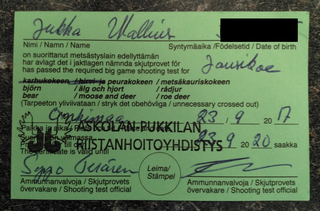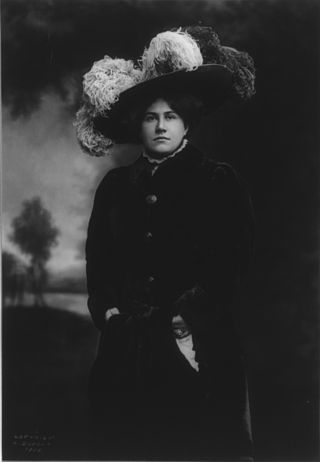The conservation movement, also known as nature conservation, is a political, environmental, and social movement that seeks to manage and protect natural resources, including animal, fungus, and plant species as well as their habitat for the future. Conservationists are concerned with leaving the environment in a better state than the condition they found it in. Evidence-based conservation seeks to use high quality scientific evidence to make conservation efforts more effective.
This is an index of conservation topics. It is an alphabetical index of articles relating to conservation biology and conservation of the natural environment.

Birdwatching, or birding, is the observing of birds, either as a recreational activity or as a form of citizen science. A birdwatcher may observe by using their naked eye, by using a visual enhancement device like binoculars or a telescope, by listening for bird sounds, or by watching public webcams.

The whooping crane is the tallest North American bird, named for its whooping sound. It is an endangered crane species. Along with the sandhill crane, it is one of only two crane species native to North America. The whooping crane's lifespan is estimated to be 22 to 24 years in the wild. After being pushed to the brink of extinction by unregulated hunting and loss of habitat to just 21 wild and two captive whooping cranes by 1941, conservation efforts have led to a limited recovery. The total number of cranes in the surviving migratory population, plus three reintroduced flocks and in captivity, now exceeds 800 birds.

The National Audubon Society is an American non-profit environmental organization dedicated to conservation of birds and their habitats. Located in the United States and incorporated in 1905, Audubon is one of the oldest of such organizations in the world. There are completely independent Audubon Societies in the United States, which were founded several years earlier such as the Massachusetts Audubon Society and Connecticut Audubon Society.
The Canadian Wildlife Service or CWS, is a Branch of the Department of the Environment, a department of the Government of Canada. November 1, 2012 marked the 65th anniversary of the founding of Service.

BirdLife International is a global partnership of non-governmental organizations that strives to conserve birds and their habitats. BirdLife International's priorities include preventing extinction of bird species, identifying and safeguarding important sites for birds, maintaining and restoring key bird habitats, and empowering conservationists worldwide.

The National Wildlife Refuge System in the United States has a long and distinguished history.

The Massachusetts Audubon Society, commonly known as Mass Audubon, founded in 1896 by Harriet Hemenway and Minna B. Hall and headquartered in Lincoln, Massachusetts, is a nonprofit organization dedicated to "protecting the nature of Massachusetts". Mass Audubon is independent of the National Audubon Society (NAS), and was founded earlier than the NAS. Mass Audubon protects more than 38,000 acres of land throughout Massachusetts, saving birds and other wildlife, and making nature accessible to all with its wildlife sanctuaries and 20 nature centers.

A hunting license or hunting permit is a regulatory or legal mechanism to control hunting, both commercial and recreational. A license specifically made for recreational hunting is sometimes called a game license.

The Connecticut Audubon Society Birdcraft Museum and Sanctuary, also known as Birdcraft Museum & Sanctuary or simply Birdcraft Sanctuary, in Fairfield, Connecticut is the oldest private songbird sanctuary in the United States. It was established in 1914 by Mabel Osgood Wright.
Coastal Prairie Conservancy was established in 1992 to conserve Katy Prairie, part of the Western Gulf coastal grasslands located in Texas, United States. Approximately 24,500 acres is under conservation easements or owned by CPC in western Harris and Waller Counties.

The Audubon Society of Portland is a non-profit environmental organization dedicated to wildlife conservancy in Portland, Oregon, United States.

Thomas Gilbert Pearson (1873–1943), was an American conservationist and one of the first faculty members at the University of North Carolina at Greensboro. He was a founder of the National Association of Audubon Societies, which became the National Audubon Society. He was also a founder of the International Committee for Bird Protection.

The natural environment, commonly referred to simply as the environment, includes all living and non-living things occurring naturally on Earth.

Rosalie Barrow Edge was an American environmentalist and suffragist. In 1929, she established the Emergency Conservation Committee to expose the conservation establishment's ineffectiveness and advocate for species preservation. In 1934, Edge also founded the world's first preserve for birds of prey—Hawk Mountain Sanctuary near Kempton, Pennsylvania. Edge was considered the most militant conservationist of her time, and she clashed publicly for decades with leaders of the Audubon Society over approaches to wildlife preservation. An environmentalist colleague described her in 1948 as "the only honest, unselfish, indomitable hellcat in the history of conservation".

Plume hunting is the hunting of wild birds to harvest their feathers, especially the more decorative plumes which were sold for use as ornamentation, such as aigrettes in millinery. The movement against the plume trade in the United Kingdom was led by Etta Lemon and other women and led to the establishment of the Royal Society for the Protection of Birds. The feather trade was at its height in the late 19th and was brought to an end in the early 20th century.












